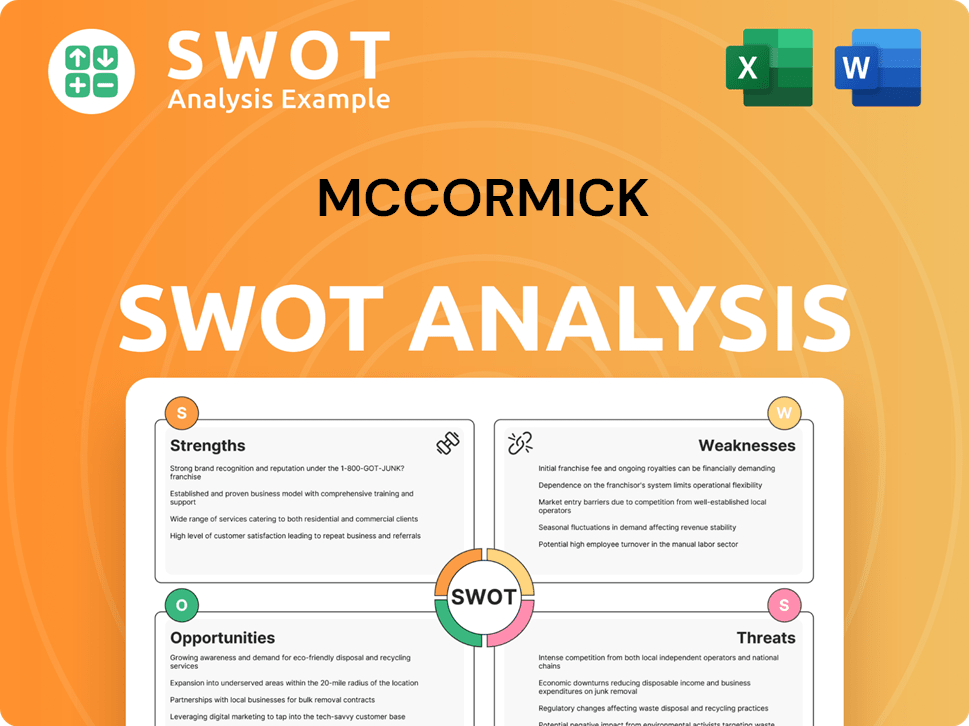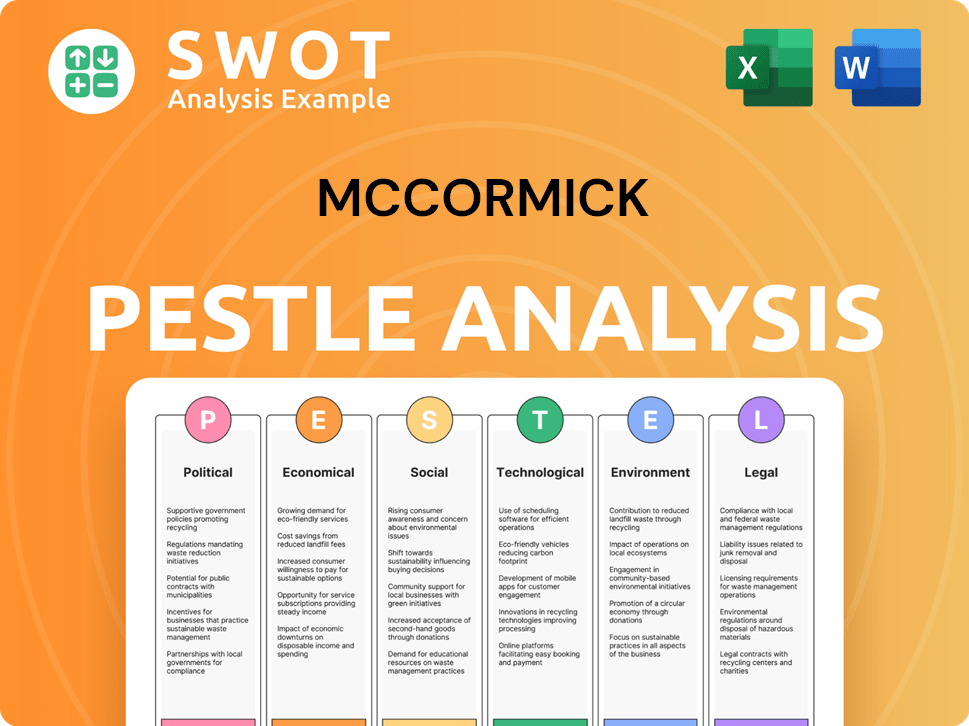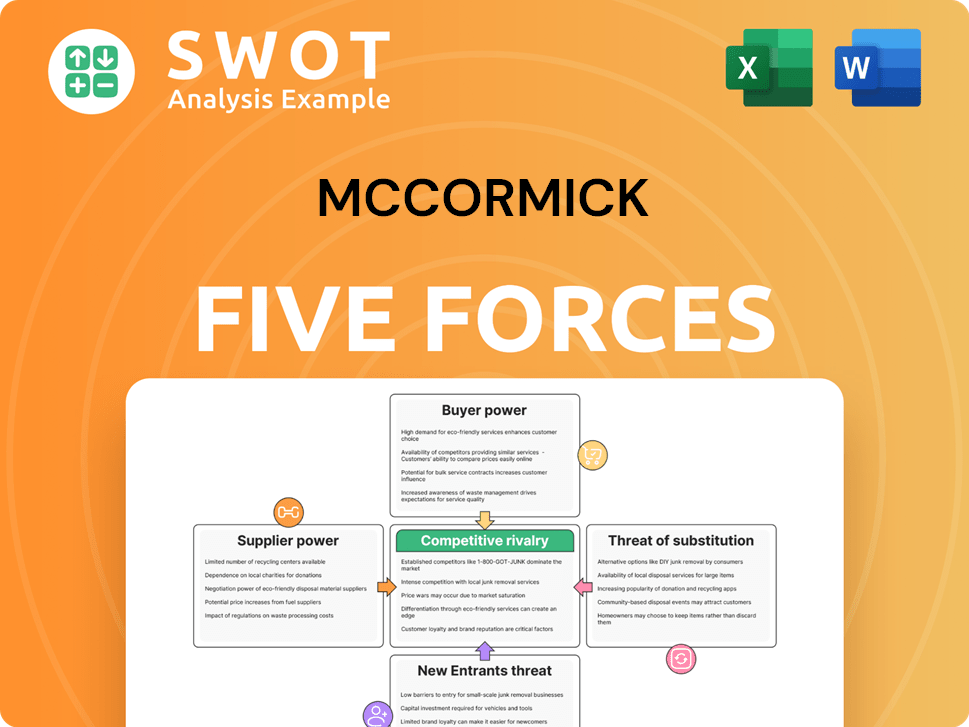McCormick Bundle
Who Buys McCormick Spices and Flavors?
Understanding the McCormick SWOT Analysis is crucial, but so is knowing who's buying their products. McCormick & Company's success hinges on deeply understanding its customer demographics and effectively targeting its market. From home cooks to global food manufacturers, the company's reach is vast and ever-evolving within the dynamic food industry.

The McCormick company has transformed from a local spice provider to a global flavor leader, necessitating a constant re-evaluation of its customer demographics. Analyzing the McCormick target market involves understanding their consumer profile, including age range, regional preferences, and buying behavior within the competitive spice market. This insight is vital for adapting product offerings and marketing strategies to maintain and expand market share in the ever-changing food industry.
Who Are McCormick’s Main Customers?
Understanding the customer demographics and target market of the McCormick company is crucial for assessing its market position. The company operates in both the consumer (B2C) and business-to-business (B2B) sectors, each with distinct customer profiles. This dual approach allows McCormick to capture a broad market share within the spice market and broader food industry.
In the B2C segment, McCormick's focus historically included home cooks and families. However, acquisitions like Frank's RedHot and Cholula have expanded its reach to younger demographics. These consumers often seek convenience and adventurous flavors. The company continuously adapts its offerings to align with evolving consumer preferences and dietary trends.
For B2B customers, McCormick serves food manufacturers and foodservice businesses. These clients prioritize consistent quality and tailored flavor solutions. The company's Flavor Solutions segment, which primarily serves B2B customers, saw a 2% sales increase in constant currency in fiscal year 2023, indicating robust growth in this area.
McCormick's consumer profile includes home cooks, families, and younger demographics (Millennials and Gen Z). These groups are interested in home cooking, baking, and enhancing meal flavors. They often seek authentic global flavors, health and wellness attributes, and sustainable sourcing. The company's marketing strategies are tailored to appeal to these diverse preferences, focusing on convenience and flavor innovation.
B2B customers include food manufacturers and foodservice businesses, such as restaurants and cafeterias. These clients prioritize consistent quality, supply chain reliability, and cost-effectiveness. McCormick provides customized flavor solutions and bulk ingredients to meet their specific needs. The company’s focus on tailored product development and bulk ingredient sales is a key part of its revenue strategy.
McCormick strategically targets both consumer and business segments to maximize market reach. The company continually adapts to changing consumer preferences and industry trends. This approach is supported by strong financial performance, with the Flavor Solutions segment showing consistent growth.
- Consumer Focus: Emphasis on home cooks, families, and younger demographics.
- B2B Focus: Catering to food manufacturers and foodservice businesses.
- Flavor Innovation: Continuously developing new flavors and product lines.
- Market Adaptation: Adjusting to evolving dietary trends and consumer preferences.
McCormick SWOT Analysis
- Complete SWOT Breakdown
- Fully Customizable
- Editable in Excel & Word
- Professional Formatting
- Investor-Ready Format

What Do McCormick’s Customers Want?
Understanding the customer needs and preferences is crucial for the success of the McCormick Company. The company's success stems from its ability to meet diverse culinary desires and practical considerations of its customers. This involves catering to the varying demands of both consumers (B2C) and businesses (B2B) within the food industry.
For B2C customers, the demand is driven by flavor enhancement, culinary inspiration, convenience, and health consciousness. Consumers seek products that offer consistent quality, ease of use, and versatility. Psychological drivers, such as the joy of cooking and the desire for variety, also influence purchasing decisions. Loyalty is often built on brand trust and positive experiences. In the B2B segment, the focus shifts to product functionality, cost-efficiency, and supply chain reliability.
McCormick's approach includes offering a wide range of standardized and customized solutions to address common pain points. Feedback from both consumer and business customers, along with broader market trends, directly influences product development. For example, the rising demand for plant-based foods and global flavors are key considerations. The company tailors its marketing by showcasing recipe ideas for consumers and highlighting technical specifications and custom solutions for its B2B partners.
Consumer preferences for flavors are constantly evolving. There's a growing interest in global cuisines and bold flavor profiles. Consumers are also increasingly seeking natural and organic ingredients.
Convenience is a significant driver for consumers. Products that are easy to use and save time are highly valued. This includes pre-mixed seasonings and ready-to-use spice blends.
Health-conscious consumers are looking for products with health benefits. This includes spices and seasonings with low sodium, no artificial ingredients, and added health benefits. The demand for plant-based foods is also growing.
B2B customers prioritize consistent quality and reliability. Food manufacturers and foodservice businesses need ingredients that meet specific formulation requirements. They also value technical support and scalability.
Reliable supply chains are critical for B2B customers. Businesses need to ensure they have a consistent supply of ingredients to meet production demands. This includes minimizing disruptions and providing dependable delivery.
Both B2B and B2C customers are seeking customization and innovation. McCormick responds by offering customized solutions for businesses and introducing new flavors and product formats for consumers. This includes adapting to changing market trends.
Understanding the factors that influence customer decisions is crucial for McCormick's success. These factors vary between B2C and B2B segments, but they all contribute to the overall market strategy. Knowing the Competitors Landscape of McCormick is also important.
- Flavor and Taste: This is a primary driver for B2C customers. Consumers seek products that enhance the flavor of their meals.
- Convenience: Easy-to-use products that save time are highly valued by consumers. This includes pre-mixed seasonings and ready-to-use spice blends.
- Health and Wellness: Consumers are increasingly health-conscious and seek products with health benefits, such as low sodium or organic ingredients.
- Quality and Consistency: B2B customers prioritize consistent ingredient quality and reliability to maintain product standards.
- Supply Chain Reliability: Ensuring a consistent supply of ingredients is critical for B2B customers to meet production demands.
McCormick PESTLE Analysis
- Covers All 6 PESTLE Categories
- No Research Needed – Save Hours of Work
- Built by Experts, Trusted by Consultants
- Instant Download, Ready to Use
- 100% Editable, Fully Customizable

Where does McCormick operate?
The geographical market presence of the company is extensive, spanning across numerous continents. Its primary markets include North America, Europe, China, and other parts of Asia, as well as Latin America. This wide reach allows the company to cater to diverse consumer profiles and preferences, solidifying its position in the global spice market and food industry.
The company has a strong presence in North America, particularly in the United States and Canada. Brands such as McCormick, Lawry's, and Frank's RedHot are well-recognized household names. The Americas region, encompassing both consumer and flavor solutions, accounted for the largest share of net sales in fiscal year 2023, demonstrating the region's ongoing significance for the company.
The company's approach to geographical market presence involves adapting strategies to local needs. This includes developing region-specific products, tailoring marketing campaigns to cultural nuances, and establishing local partnerships. Strategic expansions, such as strengthening its presence in emerging markets, are undertaken to capitalize on growing consumer bases and evolving culinary trends. Conversely, adjustments to market entry strategies are made based on market performance and competitive landscapes. Continuous analysis of sales and growth distribution helps optimize resource allocation and market penetration. For more details, you can explore Owners & Shareholders of McCormick.
The company has a strong market share in the United States and Canada. Key brands are household names, contributing significantly to the company's revenue. The consumer profile in this region is diverse, with varying preferences for spice levels and flavor profiles.
The European market presents opportunities for growth. The company tailors its product offerings to meet local tastes and preferences. There is a growing demand for organic and sustainably sourced ingredients in this region.
China and other Asian markets are crucial for expansion. The company focuses on authentic regional spices and flavor blends. Market strategies are adapted to cultural nuances and consumer buying behavior.
Latin America represents another key market for the company. The company adapts its products to suit local tastes and preferences. Focus is placed on understanding the customer demographics and market trends.
McCormick Business Model Canvas
- Complete 9-Block Business Model Canvas
- Effortlessly Communicate Your Business Strategy
- Investor-Ready BMC Format
- 100% Editable and Customizable
- Clear and Structured Layout

How Does McCormick Win & Keep Customers?
The strategies of the company for customer acquisition and retention are multi-faceted, employing diverse methods to reach both business-to-consumer (B2C) and business-to-business (B2B) customers. For B2C, the company uses a blend of traditional and digital marketing, including television ads, print media, and social media campaigns. These efforts are designed to boost culinary creativity and highlight product versatility. Digital channels, such as the company's website and social media, are crucial for recipe discovery and brand interaction. In-store promotions and merchandising are also used to attract new customers.
Loyalty is fostered through consistent product quality, building brand trust, and providing engaging content to encourage repeat purchases. For B2B clients, acquisition involves direct sales teams, industry trade shows, and developing custom flavor solutions. Retention strategies focus on strong client relationships, reliable supply chains, technical support, and collaborative product development. Customer data and CRM systems are used to tailor marketing and product offerings.
Successful acquisition campaigns highlight unique flavor profiles and quality. Retention efforts emphasize partnership and value creation. The company has increased its focus on digital engagement and e-commerce for consumers, along with sustainable and clean-label solutions for both B2C and B2B customers. These changes impact customer loyalty and lifetime value. Understanding the Brief History of McCormick helps in appreciating its long-term approach to customer relationships.
Uses television advertisements, print media, and social media campaigns to reach consumers. Collaborates with food bloggers and influencers to promote culinary creativity and product use. Employs in-store promotions and merchandising to attract new customers, focusing on the spice market.
Focuses on consistent product quality, brand trust, and engaging content. Encourages repeat purchases and usage. Leverages digital channels for recipe discovery and brand engagement. These strategies help define the consumer profile.
Employs direct sales teams and participates in industry trade shows. Develops customized flavor solutions for food manufacturers and foodservice clients. This approach is key in the food industry.
Builds strong client relationships and provides reliable supply chains. Offers technical support and collaborates on new product development. Uses customer data and CRM systems to tailor offerings.
The company has increased its digital engagement and e-commerce efforts. There's a greater emphasis on sustainable and clean-label solutions. These changes aim to boost customer loyalty and lifetime value. The company's market share analysis shows these strategies are crucial.
- Increased focus on digital engagement and e-commerce for consumers.
- Greater emphasis on sustainable and clean-label solutions for both B2C and B2B.
- These shifts influence customer loyalty and lifetime value.
- Continuous adaptation to consumer preferences and market trends.
McCormick Porter's Five Forces Analysis
- Covers All 5 Competitive Forces in Detail
- Structured for Consultants, Students, and Founders
- 100% Editable in Microsoft Word & Excel
- Instant Digital Download – Use Immediately
- Compatible with Mac & PC – Fully Unlocked

Related Blogs
- What are Mission Vision & Core Values of McCormick Company?
- What is Competitive Landscape of McCormick Company?
- What is Growth Strategy and Future Prospects of McCormick Company?
- How Does McCormick Company Work?
- What is Sales and Marketing Strategy of McCormick Company?
- What is Brief History of McCormick Company?
- Who Owns McCormick Company?
Disclaimer
All information, articles, and product details provided on this website are for general informational and educational purposes only. We do not claim any ownership over, nor do we intend to infringe upon, any trademarks, copyrights, logos, brand names, or other intellectual property mentioned or depicted on this site. Such intellectual property remains the property of its respective owners, and any references here are made solely for identification or informational purposes, without implying any affiliation, endorsement, or partnership.
We make no representations or warranties, express or implied, regarding the accuracy, completeness, or suitability of any content or products presented. Nothing on this website should be construed as legal, tax, investment, financial, medical, or other professional advice. In addition, no part of this site—including articles or product references—constitutes a solicitation, recommendation, endorsement, advertisement, or offer to buy or sell any securities, franchises, or other financial instruments, particularly in jurisdictions where such activity would be unlawful.
All content is of a general nature and may not address the specific circumstances of any individual or entity. It is not a substitute for professional advice or services. Any actions you take based on the information provided here are strictly at your own risk. You accept full responsibility for any decisions or outcomes arising from your use of this website and agree to release us from any liability in connection with your use of, or reliance upon, the content or products found herein.